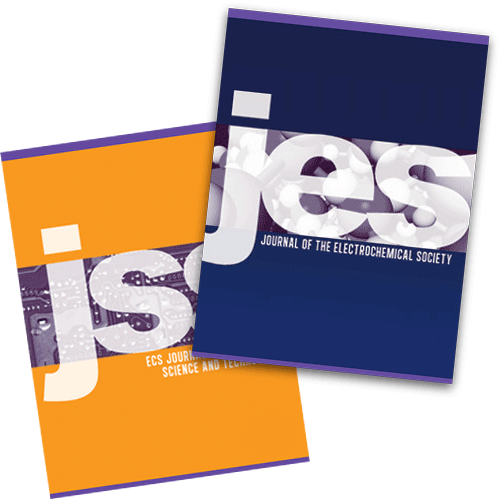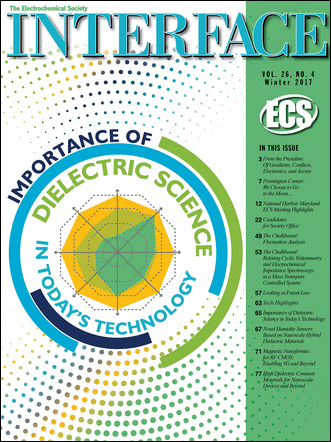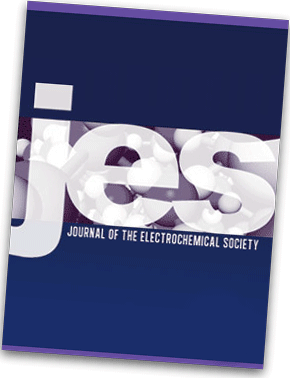 The ECS Transactions (ECST) enhanced issues for the 233rd ECS Meeting in Seattle, WA, have just opened to submissions.
The ECS Transactions (ECST) enhanced issues for the 233rd ECS Meeting in Seattle, WA, have just opened to submissions.
The following Seattle symposia will be publishing enhanced issues of ECST:
 The ECS Transactions (ECST) enhanced issues for the 233rd ECS Meeting in Seattle, WA, have just opened to submissions.
The ECS Transactions (ECST) enhanced issues for the 233rd ECS Meeting in Seattle, WA, have just opened to submissions.
The following Seattle symposia will be publishing enhanced issues of ECST:
 On January 1, 2018, ECS eliminated all charges for color figures published in the Journal of The Electrochemical Society (JES) and the ECS Journal of Solid State Science and Technology (JSS).
On January 1, 2018, ECS eliminated all charges for color figures published in the Journal of The Electrochemical Society (JES) and the ECS Journal of Solid State Science and Technology (JSS).
Figures may now be represented in color at no cost to authors in print-on-demand issues of JES and JSS.
Please note: ECS no longer offers print subscriptions to volumes of JES or JSS. Print editions of individual issues within each volume are only available as print-on-demand copies.
To have your figures represented in color in a print-on-demand issue, you must indicate that you wish to have color figures in the issue on the financial information page of your submission form.
If you do not select this option, your color figures will be converted to black and white or grayscale in the print-on-demand issue.
ECS’s decision to eliminate color charges aligns closely with the Society’s continual efforts to Free the Science, removing the barriers impeding authors from publishing their research in the formats they believe to be the most accessible and impactful. Submit today!
The following article was originally published in the winter 2017 issue of Interface.
 By: Johna Leddy, ECS President
By: Johna Leddy, ECS President
“It is all about power. If you have power, you have water. If you have water, you have food. If you have food, you can go to school. If you go to school, you have tools to think. If you have access and tools to think, you can learn those next door are not so different. You can work together to mitigate energy disparates and so reduce conflict. It is all about power.”
-ECS satellite OpenCon, October 2017
ECS looks to its future as a forum for research and a conduit for access and communication. Tenets of the scientific method are invariant, but practice of communication and access change. Change is driven by gradients. Without gradients, energy is minimized and the system dies, but if gradients are too steep, the system becomes unstable. History maps conflicts over energy and power. Early wars were over land for food energy. Distribution of natural resources and oil sustain conflicts for thermal energy. Gradients in energy distribution drive change and conflict. Going forward, access to critical materials and information, coupled with the skills and imagination to develop advanced technologies, will mitigate steep gradients in energy distribution.
 This article was originally published in the winter 2017 issue of Interface.
This article was originally published in the winter 2017 issue of Interface.
Tech Highlights was prepared by David Enos and Mike Kelly of Sandia National Laboratories, Colm Glynn and David McNulty of University College Cork, Ireland, Zenghe Liu of Verily Life Science, and Donald Pile of Rolled-Ribbon Battery Company. Each article highlighted here is available free online.
Mechanical Pre-Lithiation of Silicon Anodes for Lithium Ion Batteries
Low Initial Coulombic Efficiency (ICE) continues to be a significant issue for the practical use of alloying materials, such as Si and Ge, as anodes and particularly for their implementation in full Li-ion cells. It is imperative to develop methods to improve ICE to mitigate issues associated with the consumption of electrolyte and the loss of Li during initial cycling. Several methods
to improve ICE have been examined, including studying the effects of active material particle size and the use of various electrolyte additives such as vinylene carbonate. The prelithiation of anode materials has also been investigated using two different approaches—electrochemical and mechanical prelithiation. Researchers from the University of Tottori have reported on the formation of a crystalline Li-Si alloy phase via a mechanical alloying (MA) method. Read the full article.
 Over 1,840 articles were published in ECS journals in 2017, ranging from battery technology to materials science. Among those articles, “The Development and Future of Lithium Ion Batteries” by ECS member of 48 years, George E. Blomgren, stood out as the most downloaded paper of the year, with over 25,000 downloads in total.
Over 1,840 articles were published in ECS journals in 2017, ranging from battery technology to materials science. Among those articles, “The Development and Future of Lithium Ion Batteries” by ECS member of 48 years, George E. Blomgren, stood out as the most downloaded paper of the year, with over 25,000 downloads in total.
The open access paper was published in the Journal of The Electrochemical Society (JES) and has held the number one top download spot for the majority of the year. In November 2017 alone, it hit a record-setting 4,080 downloads. Blomgren credited the paper’s outstanding success to the continued surging interest in lithium-ion batteries, a technology that has made its profound mark on consumer electronics such as cellphones and computers, and continues to be applied to emerging innovations ranging from large scale energy storage to electric vehicles.
The paper, which highlights the past, present, and future of battery science and technology, was published as part of the JES Focus Issue of Selected Papers from IMLB 2016 with Invited Papers Celebrating 25 Years of Lithium Ion Batteries. The focus issue contains contributions from veteran scientists considered by many to be founding fathers in lithium battery science, including Emanuel Peled, Tetsuya Osaka, Zempachi Ogumi, Jeff Dahn, Robert Huggins, and of course, Blomgren.
 The Glenn E. Stoner Collection, which contains 17 articles Stoner published in the Journal of The Electrochemical Society, is available to read for free in the ECS Digital Library.
The Glenn E. Stoner Collection, which contains 17 articles Stoner published in the Journal of The Electrochemical Society, is available to read for free in the ECS Digital Library.
This sponsored collection was generously supported by Stoner’s former students, friends, and colleagues to honor the significant contributions that he made to electrochemistry and teaching.
Original plans for the collection arose during a conversation between Pat Moran, professor at the U.S. Naval Academy and member of the Free the Science Advisory Board, and E. J. Taylor, ECS treasurer and cochair of the Free the Science Advisory Board.
While the two were discussing the importance of the Free the Science initiative to the future of ECS, Moran proposed that they establish a collection in honor of their graduate advisor, Glenn E. Stoner.
A cohort of former classmates from the University of Virginia, including Paul Natishan and UVA professor Rob Kelly, took things from there, reaching out to friends, colleagues, and companies influenced by Stoner’s teaching and work.
 ECS Transactions 80(10) “Selected Proceedings from the 232nd ECS Meeting: National Harbor, MD – Fall 2017,” has just been published.
ECS Transactions 80(10) “Selected Proceedings from the 232nd ECS Meeting: National Harbor, MD – Fall 2017,” has just been published.
This issue contains a total of 149 papers from the following National Harbor symposia:
A01 – Battery and Energy Technology Joint General Session
A02 – Battery Characterization: Symposium in Honor of Frank McLarnon
A03 – Battery Student Slam 2
A04 – Li-Ion Batteries
A05 – Battery Materials: Beyond Li-Ion
A06 – Advanced Manufacturing Methods for Energy Storage Devices
B01 – Carbon Nanostructures: From Fundamental Studies to Applications and Devices
C01 – Corrosion General Session
 The following are the updated guidelines for submitting student chapter updates for publication in Interface.
The following are the updated guidelines for submitting student chapter updates for publication in Interface.
ECS encourages submissions of news from student chapters. Therefore, we try to keep the rules to a minimum. However, some guidance will help in preparing the material.
Point of View: Compose your submission in third person.
Timeliness: Interface is published every three months – spring, summer, fall, and winter. It is best that your chapter update includes information about events, initiatives, accomplishments, etc., from within the last three to six months.
 Earlier this year, a group in the ECS Corrosion Division mobilized a push to honor the work and memory of the late Hugh Isaacs, who passed away on December 5, 2016. Isaacs had been an ECS member since 1967 and is recognized as an ECS fellow.
Earlier this year, a group in the ECS Corrosion Division mobilized a push to honor the work and memory of the late Hugh Isaacs, who passed away on December 5, 2016. Isaacs had been an ECS member since 1967 and is recognized as an ECS fellow.
The group unified donors among Isaacs’s family, friends, and colleagues in an effort to commemorate all he contributed as an impassioned champion of electrochemical science and engineering, and as a preeminent figure in the corrosion community. Isaacs’s widow, Sheila Isaacs, contributed an anchor gift that helped make their endeavor possible.
Their work culminated in the creation of the Hugh Isaacs Collection, a sponsored collection containing all 45 of the articles Isaacs published in the Journal of The Electrochemical Society. The collection is currently available in the ECS Digital Library. Read now!
The content below was published in the winter 2017 edition of Interface.
 Each year ECS gives up to five Summer Fellowships to assist students in continuing their graduate work during the summer months in a field of interest to the Society.
Each year ECS gives up to five Summer Fellowships to assist students in continuing their graduate work during the summer months in a field of interest to the Society.
Congratulations to the four Summer Fellowship recipients for 2017. The Society thanks the Summer Fellowship Committee for their work in reviewing the applications and selecting four excellent recipients.
Mapping Nanoscale Ion Transport
Lushan Zhou
Transport of ions at small length scales plays critical roles in almost all physical and biophysical processes. Investigation of local ion transport properties requires tools for direct visualization of spatially distributed ions at interfaces. Scanning ion conductance microscopy (SICM), a scanned nanoscale pipette, allows high resolution non-contact topography
imaging of samples bathed in electrolyte and therefore is well-suited for nanoscale ion transport studies. Read more.